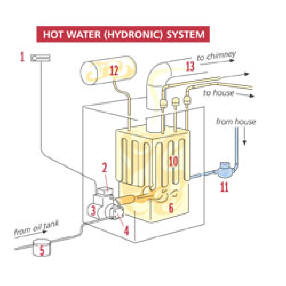


NJHIC #13VH03495400
NJHVAC #R19HC0035500


We've included the diagrams on the right to help you understand the parts that make up your heating system.
No matter which fuel your system uses, heat is distributed throughout your home in one of three ways: hot water (baseboard), steam (radiators) or warm air (vents). Two are described here. While the system you have may look a bit different, its operation is similar to those below.
How Oil Systems Make Heat
Your thermostat, (1) has a sensor that measures room temperature. When the temperature drops below your thermostat setting (or you raise the level above the room temperature), it sends a signal to the controls (2) on your burner (3) to get into action.
A fuel pump (4) draws oil through a filter (5) to your burner. It turns this oil into a fine spray, mixes it with air and ignites it in the combustion chamber (6), causing the chamber to get very hot.
What happens next depends on the type of system you have.
If you have a Hot Water (hydronic) System (upper diagram), water circulates around your boiler's heat exchanger (10). A circulator (11) pumps the hot water through radiators or baseboards. An expansion tank (12) adjusts to varying pressures.
If you have a Warm Air System (lower diagram), air absorbs heat in your furnace's heat exchanger (7). A blower (8) sends this air through ducts (9) to heat your home.
Eventually, the water or air returns to the unit and begins the cycle again.


HOW YOUR HEATING SYSTEM WORKS

Home
The Beginning
How It Works
Heating Tips
Tank Heaters
Installations
Hot Water
Alarms
Contact
